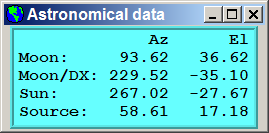
How to track a meteor shower radiant in WSJT
WSJT includes a feature that can track celestial positions. It was intended to allow to find the position of "cold sky" and well defined noise sources. It can however also be used to follow a meteor shower radiant. Here is how to do it:
- Enter RA & DEC for the radiant position under Setup>Miscellaneous>Options

- View the radiant position in View>Astronomical data>Source

Note that RA is given in decimal hours. Some data needs to be converted into that format. The radiant favours communication paths that are perpendicular (+/- 90° off) to its position. The shower is most efficient when the radiant elevation is 45°. When the radiant is under the horizon, there are no shower bursts, only sporadic meteors.
RA/DEC for some major showers:
Quadrantids RA= 15.3 hrs DEC= 49°
Perseids RA= 3.1 hrs DEC= 58°
Leonids RA= 10.2 hrs DEC= 22°
Geminids RA= 7.5 hrs DEC= 32.6°